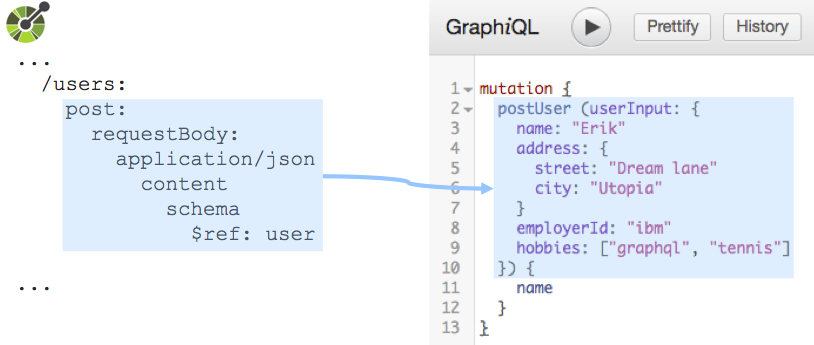Development on OpenAPI-to-GraphQL has paused. GraphQL Mesh is maintaining an OpenAPI/Swagger handler, which is fork of OpenAPI-to-GraphQL. Please find them here.
Translate APIs described by OpenAPI Specifications (OAS) or Swagger into GraphQL.
OpenAPI-to-GraphQL can be used in two ways:
The Command Line Interface (CLI) provides a convenient way to start a GraphQL server wrapping an API for a given OpenAPI Specification:
- Install the OpenAPI-to-GraphQL CLI using:
npm i -g openapi-to-graphql-cli
- Then, run the OpenAPI-to-GraphQL command and point it to an OpenAPI Specification:
openapi-to-graphql <OAS JSON file path or remote url> [options]
For further details, refer to the openapi-to-graphql-cli documentation.
Use OpenAPI-to-GraphQL as a library in your application to generate GraphQL schemas.
- Install OpenAPI-to-GraphQL as a dependency:
npm i -s openapi-to-graphql
- Require OpenAPI-to-GraphQL and use the
createGraphQLSchemafunction:const { createGraphQLSchema } = require("openapi-to-graphql"); // load or construct OAS (const oas = ...) const { schema, report } = await createGraphQLSchema(oas);
For further details, refer to the openapi-to-graphql documentation.
Here are some guides to further help you get started:
- CLI + Loopback tutorial: Learn how to quickly spin up GraphQL wrappers using the OpenAPI-to-GraphQL CLI.
- Library tutorial: Learn how to use OpenAPI-to-GraphQL as a library, and how to improve the resulting GraphQL wrappers using OAS
linkdefinitions. - LoopBack tutorial: Learn how to use OpenAPI-to-GraphQL to create GraphQL wrappers for APIs created with LoopBack 4.
- Subscriptions tutorial: Learn how to create a GraphQL API that supports subscription operations - including how to set up the API server that creates a PubSub instance wrapping a MQTT client.
-
Data-centric The GraphQL interface is created around the data definitions in the given OAS, not around the endpoints, leading to a natural use of GraphQL.

-
Nested data Links defined in the OAS are used to create nested data structures, allowing for (deeply) nested queries.

-
Automatic query resolution Automatically generated resolvers translate (nested) GraphQL queries to API requests. Request results are translated back to GraphQL responses.

-
Mutations Non-safe, non-idempotent API operations (e.g.,
POST,PUT,DELETE) are translated to GraphQL mutations. Input payload is type-checked.
-
Subscriptions GraphQL subscriptions allow clients to receive a stream of events, such as updates whenever data changes on the GraphQL server. OpenAPI-to-GraphQL can create subscriptions based on
callbackobjects defined in the OAS.
-
Authentication OpenAPI-to-GraphQL currently supports authentication via API Key and basic auth. OpenAPI-to-GraphQL wraps secured endpoints into a
viewer, which takes the API key / credentials as input.
-
API Sanitation Parts of an API that not compatible with GraphQL are automatically sanitized. For example, API parameters and data definition names with unsupported characters (e.g.,
-,.,,,:,;...) are removed. GraphQL queries are desanitized to correctly invoke the REST API and the responses are resanitized to create GraphQL-compliant results.
-
Custom request options Provide headers and query parameters to send with every API request. This allows, for example, to handle authentication or tag requests from GraphQL.
-
Swagger and OpenAPI 3 support OpenAPI-to-GraphQL can handle both Swagger (OpenAPI specification 2.0) as well as OpenAPI specification 3.
OpenAPI-to-GraphQL is written in TypeScript. Within each of OpenAPI-to-GraphQL's packages, all source code is contained in the src folder. Use yarn build or yarn test to transpile the source files into the final library in the dist folder. Entry-point for the library is index.js in dist.
Our research paper, "Generating GraphQL-Wrappers for REST(-like) APIs", can be found here. The paper describes the challenges of building OpenAPI-to-GraphQL and an experiment in which we evaluated OpenAPI-to-GraphQL against 959 publicly available OAS, provided by APIs.guru, and successfully created GraphQL interfaces for 89.5% of them.
To run the experiment, in the openapi-to-graphql package, load APIs.guru specifications, found here, into the /tmp folder:
npm run guru-loadThen, run tests:
npm run guru-test <number of APIs to test at most>-
swagger-to-graphql turns a given Swagger (OpenAPI Specification 2.0) into a GraphQL interface, which resolves against the original API. GraphQL schema is based on endpoints, not on data definitions. No links are considered.
-
json-to-graphql turns given JSON objects / arrays into a GraphQL schema.
resolvefunctions need to be provided by the user. -
StackOverflow discussion points to the above projects.




